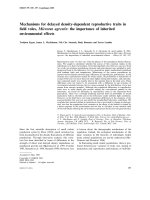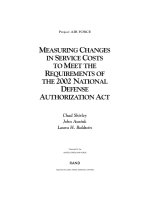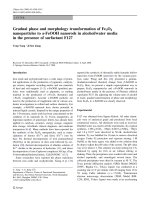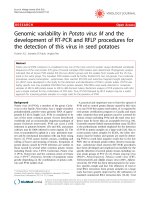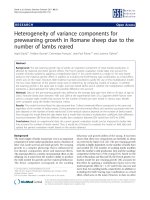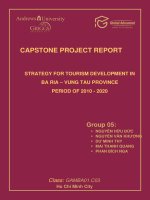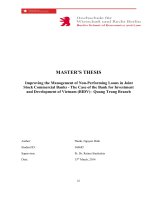Biodegradable plastic mulch for water conservation in horticultural crops
Bạn đang xem bản rút gọn của tài liệu. Xem và tải ngay bản đầy đủ của tài liệu tại đây (448.54 KB, 7 trang )
Int.J.Curr.Microbiol.App.Sci (2019) 8(2): 1731-1737
International Journal of Current Microbiology and Applied Sciences
ISSN: 2319-7706 Volume 8 Number 02 (2019)
Journal homepage:
Review Article
/>
Biodegradable Plastic Mulch for Water Conservation
in Horticultural Crops
S. Ahirwar*, M.K. Tiwari, G. Namwade and S. Bhukya
College of Agricultural Engineering and Technology, Anand Agricultural University,
Godhra, Gujarat-389001, India
*Corresponding author
ABSTRACT
Keywords
Plastic mulch,
Biodegradable
plastic mulch,
Water use
efficiency
Article Info
Accepted:
15 January 2019
Available Online:
10 February 2019
Water is the elixir of life, precise and efficient use of this elixir is very crucial
and utmost important in the busy and clutter life. Agricultural sector is the
greater consumer of water. Use of plastic mulch in agriculture sector increases
water use efficiency but problem is that removal from field after use.
Biodegradable plastic mulch offers an environmentally sustainable alternative
to conventional polyethylene mulch. In this paper, types of mulch, importance
of biodegradable plastic mulch, comparison between biodegradable plastic
mulch over different mulches, effect of temperature, evaporation, reduces
weed growth, conserve soil moisture and effect on yield are reviewed.
Introduction
Water is the elixir of life, precise and efficient
use of this elixir is very crucial and utmost
important in the busy and clutter life.
Agricultural sector is the greater consumer of
water. Agriculture accounts for 70% of all
water withdrawals globally. Irrigated land is
more than twice as productive as rain-fed
cropland (World Bank, 2017).
Use of mulch in agriculture field conserve
moisture, reduce weed growth and maintain
temperature which are favourable to plant
growth and production. Mulch is a layer of
material applied to the surface of an area of
soil to control weeds, conserve soil moisture
(reducing evaporation) and to regulate soil
temperature in favor of crop production. It
may be permanent or temporary. It may be
applied to bare soil, or around existing plants.
Mulches of manure or compost will be
incorporated naturally into the soil by the
activity of worms and other organisms. The
process is used both in commercial crop
production and in gardening, and when
applied correctly can dramatically improve
soil productivity.
1731
Int.J.Curr.Microbiol.App.Sci (2019) 8(2): 1731-1737
Benefits
Bio-degradable plastic mulch
Improve soil moisture.
Moderates soil temperature.
Reduced weed problems.
This type of plastic mulch film is easily
degraded in the soil over a period of time.
Color of film
Black plastic mulch provides good weed
control in the row. Clear plastic will require
use of herbicide. Often, weeds between mulch
strips can be controlled by herbicide.
Reduced leaching of fertilizers
Water runs off the impervious mulch,
resulting in maximum utilization of the
fertilizer.
Earlier crop production (7 to 21 d earlier in
the field).
Higher yields per unit area (2 to 3 times
higher).
Plastic mulch is practically impervious to
carbon dioxide, a gas that is of prime
importance in photosynthesis. Very high
levels of carbon dioxide build up under the
plastic, because the film does not allow it to
escape. It has to come through the holes made
in plastic for the plants and a “chimney
effect” is created, resulting in localized
concentrations of abundant carbon dioxide for
actively growing leaves.
Classification of mulches
Advancement in plastic chemistry has
resulted in development of films with optical
properties that are ideal for a specific crop in
a given location. Horticulturists need to
understand the optimum above and below
ground environment of a particular crop
before the use of plastic mulch. These are two
types.
Photo-degradable plastic mulch
This type of plastic mulch film gets destroyed
by sun light in a shorter period.
Soil environment can be managed precisely
by a proper selection of plastic mulch
composition, color and thickness. Films are
available in variety of colors including black,
transparent, white, silver, blue red, etc. But
the selection of the color of plastic mulch film
depends on specific targets. Generally, the
following types of plastic mulch films are
used in horticultural crops.
Black plastic film: It helps in conserving
moisture, controlling weed and reducing
outgoing radiation.
Reflective silver film: It generally maintains
the root-zone temperature cooler.
Transparent film: It increases the soil
temperature and preferably used for
solarization.
Apart from the above classification there is
another way of classifying Methods in
mulching:
Surface Mulching: Mulches are spread on
surface to reduce evaporation and increase
soil moisture.
Vertical Mulching: It involves opening of
trenches of 30cm depth and 15cm width
across the slope at vertical interval of 30cm.
Polythene Mulching: Sheets of plastic are
spread on the soil surface between the crop
rows or around tree trunks.
Pebble Mulching: Soil is covered with
pebbles to prevent transfer of heat from
atmosphere.
Dust Mulching: Interculture operation that
creates dust to break continuous capillaries,
and deep and wide cracks thus reducing
evaporation from the exposed soil areas.
1732
Int.J.Curr.Microbiol.App.Sci (2019) 8(2): 1731-1737
Live Vegetative Barriers on contour key
lines not only serve as effective mulch when
cut and spread on ground surface, but also
supply nitrogen to the extent of 25 to 30 kg
per ha, besides improving soil moisture status.
Why farmers are using plastic mulch?
Because main reason is, it prevent weed
growthIn 1 acre farm 3 times weeding operation is
require and in 1 time weeding operation
require 4 man days and labour cost is 300₹
per day means total cost 3600₹ is require. So
by the use of plastic mulching cost of
weeding could be eliminated.
Picture.2 Non degradable plastics
If it is not dispose properly it cause soil
pollution, pollution of the water bodies and
ultimately it reaches in nallas, lacks and rivers
which is the major problem now a day.
In order to avoid these problems
biodegradable plastic mulches provides better
alternatives.
Biodegradable plastic mulch
Picture.1 Effect of Plastic Mulching in the
Drip Irrigated Vegetable Crop
Growth of plants under plastic mulch and in
bare soil.
Non degradable plastic mulch
Main problem of plastic mulches are it is non
degradable after the use of plastic mulches it
form the residue in the field which needs to be
removed. If burning the plastic mulch it
produces the harmful gas in the air and
pollutes the environment and as a land fill it
obstruct for infiltration and percolation of
water in ground.
Mid-1970’s British and American scientists
discover biodegradable plastic derived from
corn starch. Biodegradable mulch films are
now becoming available, may be made from
renewable
resources, and are converted
through microbial activity in the soil to CO2,
water and natural substances, eliminating the
need for pick up and disposal at the end of the
season. Biodegradable plastics, as defined by
the American Society for Testing and
Materials, are “degradable plastic in which
the degradation results from the action of
naturally occurring microorganisms such as
bacteria, fungi and algae” (Mooney, 2009).
It is the intrinsic chemical structure of the
polymer that makes it biodegradable. To be
biodegradable, some parts of the polymer
main chain must be similar to naturally
occurring substances; therefore, microbes can
1733
Int.J.Curr.Microbiol.App.Sci (2019) 8(2): 1731-1737
use their existing enzymes to break the
polymer chain at those specific locations and
use them as a source of energy. For example,
microorganisms break down starch to use the
glucose, which is broken down to two
molecules of pyruvic acid, which can be
further fermented into lactic acid or
aerobically converted into CO to generate
energy. Portions of polymers that are small
enough are transferred into microbial cells
and consumed as a food source.
Biodegradation is governed by different
factors that include polymer characteristics,
type of organism, and nature of pretreatment.
The polymer characteristics such as its
mobility, tacticity, crystallinity, molecular
weight, type of functional groups and
substituents present in its structure, and
plasticizers or additives added to the polymer
all play an important role in its degradation.
During degradation, exoenzymes from
microorganisms break down complex
polymers yielding smaller molecules of short
chains, e.g., oligomers, dimers, and
monomers, that are smaller enough to pass the
semi-permeable outer bacterial membranes
and then to be utilized as carbon and energy
sources.
The
process
is
called
depolymerization. When the end products are
CO, HO, or CH, the degradation is called
mineralization.
Figure.1 Factors affecting biodegradation
During degradation, the polymer is first
converted to its monomers, and then these
monomers are mineralized. Most polymers
are too large to pass through cellular
membranes, so they must first be
depolymerized to smaller monomers before
they can be absorbed and biodegraded within
microbial cells. The initial breakdown of a
polymer can result from a variety of physical
and biological forces. Physical forces, such as
heating/cooling,
freezing/thawing,
or
wetting/drying, can cause mechanical damage
such as the cracking of polymeric materials
The biodegradation process begins once the
biodegradable material is in increased contact
with microorganism-rich environments, such
as after plowing (soil burial) or in a compost
pile. Microorganisms such as bacteria, fungi,
and algae degrade the film by using it as their
food source. Carbon removal from a starch
polyethylene blend was low compared to pure
starch, and the rate of removal was higher
under aerobic conditions.
How biodegradable plastic mulches are
made?
Two polymers that may have a role in
biodegradable plastic mulches in the future
are
polylactic
acid
(PLA)
and
polyhydroxyalkanoate (PHA). PLA is highly
versatile, biodegradable polyester derived
from 100% renewable resources such as corn
and sugar beet starch, and offers great
promise in a wide range of commodity
applications. Starch is converted by
microorganisms into lactic acid through
fermentation. Lactic acid molecules are then
linked together into long chains called
polymers. PHA polymers may be produced
from microbes or plants, but currently,
microbes are the primary source. Nonwovens
are manufactured sheets, webs or bats of
directionally or randomly oriented fibers or
filaments, bonded together. Nonwovens may
be manufactured by spunbond or meltblown
processes. In the spunbond process, polymers
are first melted and then extruded through
spinnerets, producing filaments which are
1734
Int.J.Curr.Microbiol.App.Sci (2019) 8(2): 1731-1737
cooled and laid down on a conveyer belt to
form a web. In the meltblown process,
polymers are extruded through a die or
spinneret, and filaments are stretched,
dispersed, cooled, and then collected on a roll.
Grower considerations
Degrades in field - no retrieval
Various colors are available in
biodegradable film
In biodegradable plastic mulches are
higher product cost compared to nondegradable mulches
Biodegradable plastic mulches are
available in various width - 3’ to 5’.
Effect of biodegradable plastic mulch
compare to non degradable plastic mulch:
On soil temperature (Incalcaterra et al.,
2004)
than those in the bare soil. Night and predawn soil temperatures in the soil plots
covered with black PE film were higher (from
4.2 to 5.5 °C) than those in the bare soil.
Whereas, during the same day periods, soil
temperatures in the transparent PE film plots
were from 0.9 to 1.6 °C higher than those in
the bare soil. Pre-dawn soil temperatures in
the plots covered with transparent or black
biodegradable Mater-Bi films, although
higher than those in the bare soil were much
lower than those under black PE film and
comparable to those measured in the
transparent PE plots.
Black PE film has a high short wave
absorbance; the incoming radiation is first
absorbed by the plastic and then transmitted
to the soil by conduction. We can speculate
that in absence of solar radiation, heat loss
due to long wave infrared radiation was
higher in the plots covered with black and
transparent Mater- BiTM films, and transparent
PE as compared to that of black PE film. All
mulches induced an earlier plant emergence
(about 4 days) in comparison to bare soil
plots.
Effect of soil cover on maximum, minimum
and average soil temperature (°c) at 5cm
depth (Bell Pepper) (June 4 - July 10)
(Warner et al., 2010)
Soil Cover
Figure.2 Diurnal patterns of soil temperature
at the 5 cm depth. Data are shown for each of
the plastic mulches and the bare soil plot
All mulches increased soil temperatures in
comparison to the bare soil plots (Fig. 2).
Maximum soil temperatures (ranging from
25.8 to 33.8 °C) were measured under
transparent PE and transparent biodegradable
Mater-Bi films between 7:00 and 17:00 h.
During this day period soil temperatures of
these plots were from 3.7 to 8.6 °C higher
Mean Maximum Mean Minimum Average
Temperature
Temperature
Temperat
ure
Bare Soil
27.8
16.8
21.8
Black
Plastic(non
degradable)
29.6
19.2
23.9
Biolene
(Biodegrad
able)
29.2
19.2
23.8
Biodegradable plastic mulches are not
significantly different from black plastic
mulch but it is significantly different from the
bare soil.
1735
Int.J.Curr.Microbiol.App.Sci (2019) 8(2): 1731-1737
significantly affect the microclimate around
the crop canopy by changing the radiation
budget of the soil top, soil water
transformation, aerodynamic properties, and
soil temperature so as to influence the crop
yield (Y), evapotranspiration (ET), and water
use efficiency (WUE). WUE (kg/m3) was
calculated as the grain yield (kg/hm2) divided
by the total ET (mm) from sowing to harvest.
Effect on yield
Mulch
Early
Marketable
Yield (Tonnes
/ha)
Total Yield
(Tonnes/ha)
Melon
Bare Soil
2.4
15.9
Black Plastic
Mulch
16.8
20.0
Biodegradable
plastic mulch
Bell Pepper
17.2
19.2
Bare Soil
38.2
52.9
Black Plastic
Mulch
Biodegradable
plastic mulch
Broccoli
39.1
49.5
Mulching material
WUE (kg/m³)
37.7
45.8
Bare soil
2.50
Black plastic mulch
3.27
Bare Soil
1.6
2.8
Biodegradable plastic
mulch
3.25
Black Plastic
Mulch
Biodegradable
plastic mulch
3.7
4.3
2.7
3.5
Water use efficiency for Maize Crop
(Yang et al., 2015)
All mulches markedly increased early and
total yields in comparison to unmulched plots.
The higher soil temperatures produced by the
transparent films in combination with the use
to maximize available water resources, played
a major role in increasing early melon, bell
pepper and broccoli and total yields. In this
study transparent PE (non degradable) mulch
and transparent Mater-BiTM (bio degradable)
mulch had similar marketable early and total
yields. The Mater-Bi film adds the advantage
of rapid degradation to many of the desirable
effects of plastic mulch and therefore, it
represents an environmentally friendly
alternative to PE film mulching.
Water-saving
mechanism
and
enhancement of efficiency with mulching
Mulching
materials
and
techniques
Water use efficiency of biodegradable plastic
mulch is similar to that of black plastic mulch
but it is significantly different from bare soil.
Effect of type of mulch on soil cover rating
for various dates (Warner et al., 2010)
Bio-lene Black plastic
Jun 11
1
0
Jun 23
1
0
Jul 08
1
0
Jul 22
1
0
Jul 30
1.3
0
Aug 14
2.3
0
Aug 30
2.3
0
Sep 13
3
0
Oct 01
4.5
0
0 to 5 rating (rated every 2 weeks):
0 = no breakdown of mulch, 100% soil cover.
1 = small holes forming in mulch, nearly
100% soil cover.
1736
Int.J.Curr.Microbiol.App.Sci (2019) 8(2): 1731-1737
2 = one or more small tears over 30 cm long,
> 90% soil cover.
3 = multiple tears and holes in mulch, 75 to
90% soil cover.
4 = multiple tears and holes, 50 to 75% soil
cover.
5 = mulch largely deteriorated, < 50% soil
cover.
The conclusions of the study are as follows
Increase in soil
temperature under
biodegradable plastic mulch (23.8°C) is
almost equal to that under non-degradable
plastic mulch (23.9°C). No significant
difference was observed for total and
marketable yield over the season. In case of
effect on early yield, Bell pepper has no effect
but Melon increases (4 days early emergence)
Not significant difference was observed in
water use efficiency. Biodegradable plastic
mulch (3.25kgm-3) and non degradable plastic
mulch (3.27kgm-3) was observed.
The performances of biodegradable plastic
mulch is similar to black polyethylene mulch
but with an advantage that field removal of
the biodegradable films are not required at the
end of the season. It starts to degrade in about
45 to 50 days after laying the mulch except
Green plastic (biodegradable) Mulch.
References
and Lapichino, G., (2004). Agronomic
response of Water Melon (Cucumis
melo inodorus Noud.) to biodegradable
and polyethylene film mulches, and to
different plant densities. Mediterranean
rainfed Agriculture: strategies for
sustainability. 60: 181-184.
López-Marin, J., Fernández, J. A., Pablos, J.
L.
and
Abrusci,
C.
(2012)
Biodegradable Mulch Film in a
Broccoli Production System. Acta Hort.
933: 439-444.
López, J., González, A., Fernández, J.A. and
Bañón, S. (2007). Behaviour of
biodegradable films for mulching in
melon cultivation. Acta Hort. 747: 125130.
Mooney, B. P. (2009). The second green
revolution? Production of plant-based
biodegradable plastics. Biochemical
Journal, 418(2), 219-232.
Warner, J. and Zandstra, J. (2010).
Biodegradable Polymer Mulches in Bell
Pepper Production. Agriculture and
Agri-Food 23: 151-163.
Yang, N., Sun, Z., Feng, L., Zheng, M., Chi,
D., Meng, W., Hou, Z., Bai, W., and Li,
K. (2015) Plastic film mulching for
water-efficient agricultural applications
and
degradable
films
materials
development research. Agricultural
Engineering. 30(2), 143-154.
Incalcaterra, G., Sciortino, A., Vetrano, F.,
How to cite this article:
Ahirwar, S., M.K. Tiwari, G. Namwade and Bhukya, S. 2019. Biodegradable Plastic Mulch for
Water Conservation in Horticultural Crops. Int.J.Curr.Microbiol.App.Sci. 8(02): 1731-1737.
doi: />
1737
